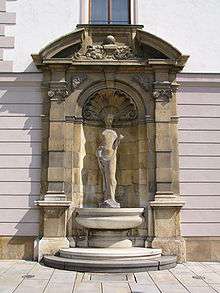Camillo Sitte
.jpg)
Camillo Sitte (17 April 1843 – 16 November 1903) was a noted Austrian architect, painter and city planning theoretician with great influence and authority of the development of urban construction planning and regulation in Europe.
Life
Camillo Sitte was born and died in Vienna. He was an art historian and architect. He traveled around the towns of Europe and tried to identify aspects that made towns feel warm and welcoming. Architecture was a process of culturization for him. Sitte received a lot of attention in 1889 with the publication of his book "Der Städtebau nach seinen künstlerischen Grundsätzen" (English title: "City Planning According to Artistic Principles"). The richly illustrated book pointed out that the urban room around the experiencing man should be the leading motif of urban planning, thus turning away from the pragmatic, hygienic planning procedures of the time. Sitte emphasized the creation of an irregular urban structure, spacious plazas, enhanced by monuments and other aesthetic elements.
Sitte founded the Camillo Sitte Lehranstalt and the Camillo Sitte Gasse in Vienna, and also the magazine Städtebau in 1904. Camillo Sitte was the son of the architect Franz Sitte (1808–79) and the father of the architect Siegfried Sitte (1876–1945).
City Planning According to Artistic Principles (1889)
The work of Sitte is not exactly a criticism of architectural form, it is more precisely an aesthetic criticism of the nineteenth century's end urbanism. Mainly an urban planning theory book, it has a deep influence in architecture, as the two disciplines are deeply intertwined. It was also highly successful in its time. Between 1889 and 1922 it was edited five times. It was translated into French in 1902 but was not translated into English until 1945.
For Sitte, the most important is not the architectural shape or form of each building, but the inherent creative quality of urban space, the whole as much more than the sum of its parts. Sitte contended that many urban planners had neglected to consider the vertical dimension of planning, instead focusing too much on paper, and that this approach hindered the efficacy of planning in an aesthetically conscious manner. Athens and the ancient Greek spaces, like the agora and the forum are his preferred examples of good urban spaces. He makes a study of the spatial structures of the cities, squares, monuments, and confronts the living beauty and creativity of the most ancient ones with the sterility of the new cities. In general:
- Sitte makes an analysis based on sensitivity aesthetics and is not concerned with the historical circumstances that generated such forms. Urbanism is to be lived today and thus must be judged according to today's needs and aesthetics;
- Criticizes the regular and obsessive order of the new squares, confronting it with the irregularity of the medieval city. "A square should be seen as a room: it should form an enclosed space";
- Criticizes the isolated placement of churches and monuments, and confronts it with how monuments were formerly presented to the viewer;
- With examples from Italy, Austria and Germany, he defines a square typology, an "enclosed squares' system of the ancient times". He studies from a psychological viewpoint the perception of the proportions between the monuments and its surroundings, opposing the fashion of very wide streets and squares, and the dogma of orthogonality and symmetry;
- He fears that Urbanism would have become a mere technical task without any artistic involvement. He acknowledges an antagonism between the picturesque and the pragmatic, and states that these restrain the works of the artists. The building of another Acropolis would become impossible, not only because of the financial means, but also the lack of the basic artistic generating thought;
- He stated that an urban planner should not be too concerned with the small design. The city should only take care of the general streets and structure, while the rest would be left to private initiative, just as in ancient cities;
- He provides an example of his theories at the end of one of his books in the form of the redesign of Vienna's Ring, a circular avenue.
His theories were widely influential for many practiticians, like Karl Henrici and Theodor Fischer. Modernist movements rejected these thoughts and Le Corbusier is known for his energetic dismissals of the work. Nevertheless, his work is often used and cited as a criticism of the Modernist movement, its importance reemerging in the post-modernist movement of the late sixties.
Books by Sitte
- City Planning According to Artistic Principles, 1889
- The Birth of Modern City Planning. Dover Publications, 2006, ISBN 978-0-486-45118-3
- Gesamtausgabe. Schriften und Projekte. Hrsg. v. Klaus Semsroth, Michael Mönninger und Christine Crasemann-Collins. 6 Bände. Böhlau, Wien 2003–2007
Literature
- Karin Wilhelm, Detlef Jessen-Klingenberg (Hrsg.): Formationen der Stadt. Camillo Sitte weitergelesen (= Bauwelt Fundamente; Bd. 132). Birkhäuser, Basel; Bauverlag, Gütersloh u. a. 2006, ISBN 3-7643-7152-8
- George R. Collins & Christiane Crasemann Collins. Camillo Sitte and the Birth of Modern City Planning. Random House: New York, 1965.
- Michael Mönninger: Vom Ornament zum Nationalkunstwerk. Zur Kunst- und Architekturtheorie Camillo Sittes. Vieweg, Wiesbaden 1998, ISBN 3-528-02423-2
- Leif Jerram: From Page to Policy: Camillo Sitte and Planning Practice in Munich. Manchester Papers in Economic and Social History, No. 57, September 2007. ISSN 1753-7762. An introduction to Sitte, alongside an analysis of how his ideas were actually used. Available online at http://www.arts.manchester.ac.uk/subjectareas/history/research/manchesterpapers/ .
External links
| Wikimedia Commons has media related to Camillo Sitte. |
- Camillo Sitte in the German National Library catalogue
- "Camillo Sitte". Aeiou Encyclopedia (in German).
- Camillo Sitte at the archINFORM database.
- The Camillo Sitte Lehranstalt
- The biography of Camillo Sitte
- Internationally acclaimed cityplan for the Swedish housing area Bagaregården by Albert Lilienberg who was inspired by Camillo Sitte
- Camillo Sitte and his influences in Sweden (in Swedish)
